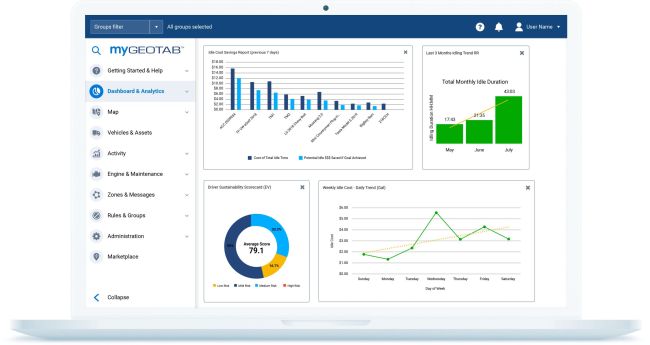
6 Factors to Consider When Developing or Updating Your Fleet’s Idling Policy
When it comes to unnecessary fuel waste and carbon emissions, idling is a notorious offender. Creating a new policy or updating an existing one can help you keep it in check – and considering these six factors can help you get a jump start.
1. The Right Time
If your fleet hasn’t established an idling policy, now is the time to start that process. If developing a new policy seems overwhelming, it’s OK to start simple and update it as you go. Even small steps toward reducing idling can save you money and cut emissions.
If it’s been several years since you’ve updated your idling policy, now is also a good time to review it. Technology and environmental regulations have changed significantly in just the last few years, and both can trigger the need for updates.

“Fleets should consider updating their idling policy whenever there are regulatory changes regarding idling and vehicle emissions,” said Sean Umland, automotive engineering manager for New York-based Con Edison. “New advances in technology are constantly emerging, and it is best to incorporate this into your strategy and policy, too. If there are any changes to the company’s internal sustainability goals, it is best to review your idling policy and make any necessary updates.”
Umland also said an increase in any of the following metrics is a good indicator of the need to create or update an idling policy:
- Average idle times and idling trends.
- Yearly greenhouse gas emissions levels.
- Fuel consumption.
2. True Idling
When thinking through an idling policy, Stephen White, associate vice president of enterprise sales for Geotab (www.geotab.com), a provider of connected transportation and asset solutions, recommends addressing two kinds of idling: true idling and operational idling.

True idling is when a vehicle is left running and never changes location, like when an operator leaves a truck or van running to keep it cooled or heated. True idling serves no operational purpose, wastes fuel and results in unnecessary emissions.
“In a small bore diesel engine, idling wastes about eight-tenths of a gallon on average,” White said. “A large bore diesel engine, which doesn’t cover most of the Class 8 trucks, wastes approximately 1.5 gallons per hour. Multiply that by 1,000 or even 10 trucks and it becomes a significant amount of fuel and dollars, as well as the additional pounds of CO2. That’s a lot of waste for no reason.”
While the goal is to have zero true idling, a policy should define how much idle time is acceptable and what the consequences are for exceeding that limit.
3. Operational Idling
Operational idling occurs when a stationary vehicle must idle to run power to external equipment from the vehicle, as with power takeoff (PTO).
“The problem usually is that the truck is left idling before and after it’s needed,” White said. “For instance, if a utility company is repairing power lines, the boom truck only needs to be idling when cycling up and cycling down. But a lot of times, when the bucket is either up or down, the truck is still idling, which isn’t necessary.”
Telematics can help fleets monitor idling data to determine an acceptable amount of true idling before and after operational idling; those parameters can then be included in the idling policy.
“For years, people just looked at the total idle time, and they couldn’t break it down between what is operational idling and what is the true idle,” White said. “Now they can look at idling at a granular level and decide if it’s operational idling or if it’s true idling but from the operation of that vehicle. Using MyGeotab, fleets can monitor PTO usage on most bodies so you can see exactly when that PTO was engaged, when it was disengaged, and then also compare that to the engine idling.”
4. Environmental Regulations
Idling policies should include current environmental regulations to ensure compliance. Fleets making policy updates will want to consider recent changes to local, state and federal regulations regarding vehicle emission standards.
“Our idling policy reflects the local regulations that govern idling and vehicle emissions in our region,” Umland said. “The focus is to ensure that we are complying with these standards and lowering our environmental impact. If your fleet operates under an ordinance where there are fines attributed to idling, it is important to track the volume of these fines your company is receiving. By maintaining a database, you can ensure that you are lowering the total number of infractions year over year.”
5. Consequences and Incentives
An idling policy is only as good as the level to which it’s followed, so it’s important to include the consequences of exceeding the policy limits as well as the rewards operators receive for idle reduction.
“We track compliance through our telematics equipment that is installed in every vehicle in the fleet,” Umland said. “The ability to run specific idling reports helps us track and identify idling trends and patterns.”
White said defining average fuel economy in an idling policy and then rewarding drivers based on their individual performance against it can motivate operators to comply.
“You might say, ‘The company average is 6.2 miles per gallon, and for every mile per gallon you exceed over that, you can make X more dollars.’ We’ve seen this have an immediate effect. One of our customers cut idling by about 8.4%, which was about $50,000 in fuel a month. So, it can have a very immediate and widespread impact,” he explained.
6. Reasonable Goals
If drivers comply with your new or updated idling policy, what results do you expect to see? Including these in your policy helps align drivers with a common goal.
“It’s important to make your goals reasonable,” White said. “You can always increase the number. Start at a 5% idling reduction goal, then six months later, bump it up to 10% or 15%. Then at the end of the year, finish up at 30%. But the most important thing to do is just start.”
About the Author: Shelley Mika is the owner of Mika Ink, an Omaha, Nebraska-based branding and marketing communications agency. She has been writing about the fleet industry since 2006.
Hexagon Purus has announced it will be supplying components to Toyota Motor North America for serial production of its heavy-duty fuel cell electric powertrain kits. Hexagon Purus will be providing a full hydrogen storage system and high-voltage battery pack for the kits. The company’s collaboration with Toyota started in 2017. … Mullen Automotive Inc., an emerging electric vehicle manufacturer, recently announced that the California Air Resources Board has approved the company’s all-electric Class 3 low cab forward – the 2024 Mullen THREE – for the Hybrid and Zero-Emission Truck and Bus Voucher Incentive Project (HVIP). The HVIP program plays a crucial role in the deployment of zero-emission technologies and accelerates commercialization by providing point-of-sale vouchers to make advanced vehicles more affordable. … Isuzu North America Corp. has announced the development of an all-new, zero-emission Isuzu Class 6 and 7 truck utilizing an Accelera by Cummins powertrain for both the U.S. and Canada. This truck represents the first zero-emission solution facilitated by the Isuzu Cummins Powertrain Partnership formed in May 2019. Currently the vehicle’s availability is slated for 2026.

